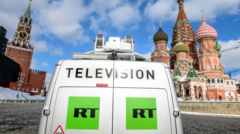Russia has suffered more than 600,000 casualties in the war with Ukraine, a senior U.S. defense official said on Wednesday.
The number of Russian dead or wounded is significantly higher than the last official update from the U.S., which had estimated more than 300,000 casualties since the war began in February 2022.
The U.S. official said Russia sustained more casualties in September of this year than at any other point in the war, and explained it was important to disclose the casualties even if it is not a "definitive metric" of success in the conflict.
Russian President Vladimir "Putin is trying to avoid a mass mobilization because of the effect that would have on Russia's domestic population," the official told reporters. "At this point, he has been able to significantly increase the pay of these voluntary soldiers, and he has been able to continue to field those forces without doing a major mobilization.
"And I think we're just watching very closely how long that stance can actually be one that he can maintain, and I think it's an important one for all of us to watch very closely," they added.
Russia has also lost 32 medium-to-large naval vessels to Ukraine, which has hammered Russian forces in the Black Sea with drones, and "destroyed more than two-thirds of Russia's pre-war inventory of tanks," according to the U.S. official. Ukraine has also destroyed hundreds of thousands of ammunition rounds in targeted strikes.
The U.S. has not disclosed the number of Ukrainian casualties. Ukrainian President Volodymyr Zelensky said in February that some 31,000 troops had been killed.
Russian forces have continued to press forward on the battlefield stretching across a 600-mile front of eastern Ukraine, using a strategy of deploying mass waves of troops to overwhelm Ukrainian defenses despite the risk of high casualties.
Russia has made some progress in the eastern Donetsk region, taking the town of Vuhledar earlier this month and pressing toward the city of Pokvorsk, a railroad hub and critical supply station for Ukraine that could hinder Kyiv's defense efforts if it falls.
A senior U.S. military official said the Russian strategy, particularly around Vuhledar and Pokvorsk, has incurred "substantial casualties" for minor gains.
"The number of Russians in [Povkorsk] is astounding, it's tens of thousands of forces," the official said. "When you have that many forces in a very small area, indirect fire of any kind, or any direct fire, for that matter, it's a target-rich environment."
Heavy fighting is also in Russia's region of Kursk, which Ukrainian forces invaded in early August in a largely failed bid to divert Russian troops from the frontlines. Kyiv has said other goals, including preventing a Russian assault from Kursk, have been achieved in the incursion.
The senior military official said Wednesday that the Ukrainian troops can hold onto the territory in Kursk for months or longer.
The military official added there have been "overall minor changes" on the battlefield in both Kursk and Donetsk in recent weeks, adding that Russia is expected to continue its mass pressure campaign but Ukraine is "thinking forward to 2025" with an eye on boosting brigades with recruitment.
The U.S. is continuing to pour billions into the fight to defend Ukraine. Last month, President Biden announced around $8 billion for Kyiv that will be sent over from U.S. defense stocks or purchased from private industry and deployed through January. The money is the last available funds for Ukraine's security needs that was approved by Congress in April.
Zelensky, who was in the U.S. for a United Nations General Assembly meeting last month, presented a victory plan to Biden when he visited the president at the White House. The details of that plan have yet to be released.
Biden was expected to hold a key meeting of Western leaders in Germany this weekend to discuss Ukraine support, but the trip was canceled as the U.S. grapples with the response to Hurricane Helene and the incoming powerful Hurricane Milton.
Despite Zelensky's frequent calls, the Biden administration has refused to reverse a policy that prevents Ukraine from using U.S.-made weapons, such as the Army Tactical Missile System (ATACMS), to strike deep inside of Russia and damage Russian airfields to damage capabilities and prevent the use of powerful weapons like glide bombs.
The U.S. is primarily concerned about escalation. Putin last month issued a threat when he said that Russia could deploy tactical nuclear weapons against a country backed by a nuclear power.
The U.S. defense official said they are still not considering reversing the policy, saying the ammunition for deep strikes has "finite quantities" and they have to "look at risks of escalation."
"In terms of effectiveness, we also have to look at whether the quantities that exist -- and again, they are limited -- whether they would have the strategic effect," the official said. "And we certainly know that many of the capabilities that are of greatest concern, particularly for glide bomb use, for instance, have actually moved out beyond ATACMS range."















 English (US) ·
English (US) ·